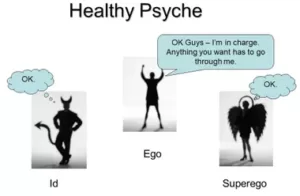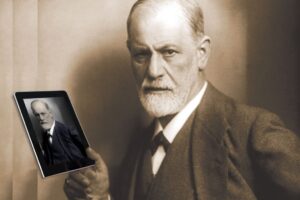 Psychoanalysis operates on the basic division of mental life into conscious processes and the unconscious. Psychoanalysis is defined as a set of psychological theories and therapeutic methods which have their origin in the work and theories of Sigmund Freud. The primary assumption of psychoanalysis is the belief that all people possess unconscious thoughts, feelings, desires, and memories In The Interpretation of Dreams, Freud thinks of this division in a primarily ‘topological’ way. He conceives of the human mind in the spatial metaphor of topography in which the conscious mental system is divided from the unconscious one. This is a common division that we can now easily understand.
Psychoanalysis operates on the basic division of mental life into conscious processes and the unconscious. Psychoanalysis is defined as a set of psychological theories and therapeutic methods which have their origin in the work and theories of Sigmund Freud. The primary assumption of psychoanalysis is the belief that all people possess unconscious thoughts, feelings, desires, and memories In The Interpretation of Dreams, Freud thinks of this division in a primarily ‘topological’ way. He conceives of the human mind in the spatial metaphor of topography in which the conscious mental system is divided from the unconscious one. This is a common division that we can now easily understand.
The unconscious is further divided between the ‘unconscious’ and the ‘preconscious’. Some elements of the unconscious pass more easily into conscious thought than do others. The preconscious consists of all of those thoughts and memories that are not actively in conscious thought but which can easily become conscious when they are triggered by a thought, a suggestion, a comment in a conversation, a reminder. These are often things that we have forgotten or wish we have forgotten, but their presence in our consciousness does not pose a significant risk to our well-being. Those thoughts and feelings that come easily to mind, even if they are uncomfortable, are preconscious. In the unconscious are those thoughts, fantasies, or wishes that, were they to be directly expressed in consciousness, would give rise to considerable distress. For example, incestuous wishes or aggressive impulses towards one’s parents or brothers and sisters are often too difficult for the consciousness to bear and they remain unconscious through the mechanism of repression. We run a considerable risk of pain if we entertain aggressive thoughts and feelings towards our parents or brothers or sisters for too long or if we too openly declare these thoughts. Regardless, we harbor aggressive wishes and thoughts towards those we are supposed to love – our parents, our partners We are able to hold on to these thoughts only if we remove them from consciousness unless we find a way to express those same feelings without risking too much pain. If we hold on to them and do not give them any expression, their dangerous power increases and they become all the more intolerable to conscious or preconscious thought. Even in his early work, Freud thought about human mental functioning in a dynamic way. That is, he thought about the unconscious in dynamic terms as a wishing machine.
As his thought developed over time, he came to emphasize the dynamic conception of the mind and developed a second topography in 1923, in The Ego and the Id. It is in this book that the classic Freudian terminology becomes fully systematized in terms that are perhaps most famous in psychoanalysis: Ego, Super-Ego, Id. Freud systematizes the terms in this book, but he had been using these terms in his work for some time. The Ego is what we know as the conscious ego. The Ego is the I that is conscious of itself as an I. The Id is Freud’s name for the dynamic unconscious. The Super-Ego is a part of the Ego that contains the idealizations of the Ego and, for this reason, is also known as the Ego-Ideal The Super-Ego develops in us through the experience of the family romance or the Oedipus complex. In the Oedipal situation, the child wishes to obtain all of the satisfactions attached to his preferred parent. The child wishes to be the one and only adored of that parent, to take that parent as his own or her own:
The child’s parents, and especially his father, were perceived as the obstacle to a realization of his Oedipus wishes; so his infantile ego fortified itself for the carrying out of the repression by erecting this same obstacle within itself. It borrowed the strength to do this, so to speak, from the father.
Freud assumes the Oedipus complex on clinical grounds and its resolution helps to account for the installation. of the Super-Ego in the ego as a kind of ‘categorical imperative’ .The ‘categorical imperative’ is a term that comes from the ethical philosophy of Immanuel Kant (1724-1804). For Kant, the categorical imperative is a formulation of the moral law that will be valid in any and all circumstances without contradiction. In psychoanalytic terms, The super-ego retains the character of the father, while the more powerful the Oedipus complex was and the more rapidly. it succumbed to repression (under the influence of authority, religious teaching, schooling, and reading), the stricter will be the domination of the super-ego over the ego later on-in the form of conscience or perhaps an unconscious sense of guilt.The Super-Ego is installed in the mind as the force of the moral law that is acquired through the dissolution of the Oedipus complex. The conception of the mind that emerges in Freud’s thought is a dynamic process of inter-relations among the Id the primary process unconscious that wishes-the Ego where conscious thought takes place and the Super-Ego that demands the ego conform to the prescriptions of the law. The psychoanalytic conception of the mind, and of the drama of human development, open spaces for literary and cultural critics to situate the works that we study in the context of the human practices that the texts represent. Psychoanalytic criticism and theory that attend to the mental, cultural, historic, and mythological dimensions of the literary text allow us a way to understand the theinter-subjective situation of literature, which, by its very nature, puts an audience into relations with a text and with others. The psychoanalytic description of mental life allows literary critics to understand the ways in which the representations that we read and study map onto broader human experience and processes. We find our mothers or our fathers, our sisters and ourselves, and through that process, come to find solutions to the conflicts that are part of all human communities.
vinodhan,
Courtecy -Sigmund Freud and the Itinerary of Psychoanalysis ,The Unconscious by Sigmund Freud


